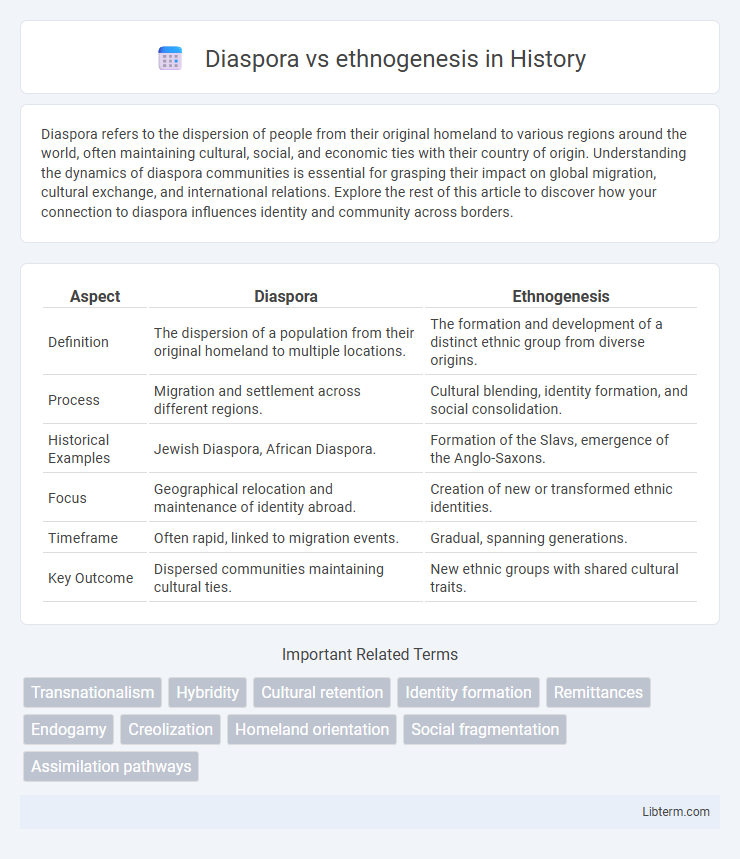Diaspora refers to the dispersion of people from their original homeland to various regions around the world, often maintaining cultural, social, and economic ties with their country of origin. Understanding the dynamics of diaspora communities is essential for grasping their impact on global migration, cultural exchange, and international relations. Explore the rest of this article to discover how your connection to diaspora influences identity and community across borders.
Table of Comparison
| Aspect | Diaspora | Ethnogenesis |
|---|---|---|
| Definition | The dispersion of a population from their original homeland to multiple locations. | The formation and development of a distinct ethnic group from diverse origins. |
| Process | Migration and settlement across different regions. | Cultural blending, identity formation, and social consolidation. |
| Historical Examples | Jewish Diaspora, African Diaspora. | Formation of the Slavs, emergence of the Anglo-Saxons. |
| Focus | Geographical relocation and maintenance of identity abroad. | Creation of new or transformed ethnic identities. |
| Timeframe | Often rapid, linked to migration events. | Gradual, spanning generations. |
| Key Outcome | Dispersed communities maintaining cultural ties. | New ethnic groups with shared cultural traits. |
Understanding Diaspora: Definitions and Contexts
Diaspora refers to the dispersion of a population from their original homeland, often maintaining social, cultural, and emotional ties to their place of origin while adapting to new environments. Ethnogenesis involves the formation and development of a distinct ethnic group through processes such as migration, intermarriage, and cultural exchange. Understanding diaspora requires analyzing historical migration patterns, transnational connections, and identity preservation within global contexts.
Ethnogenesis: The Birth of New Identities
Ethnogenesis refers to the process through which new ethnic identities are formed, emerging from the blending of diverse cultural, social, and historical influences. This dynamic phenomenon often occurs when groups undergo significant changes in migration, conflict, or assimilation, resulting in unique communal narratives and shared symbols solidifying group cohesion. Unlike diaspora, which involves the dispersion of pre-existing ethnic groups, ethnogenesis marks the creation of distinct identities that redefine social boundaries and collective memory.
Historical Perspectives on Diaspora and Ethnogenesis
Diaspora refers to the dispersion of a people from their original homeland, often resulting in the formation of migrant communities that maintain cultural ties across borders. Ethnogenesis involves the process through which new ethnic groups emerge, shaped by shared experiences, cultural adaptations, and historical circumstances. Historical perspectives on diaspora emphasize migration and displacement events, while ethnogenesis highlights the dynamic formation of group identities over time.
Key Differences Between Diaspora and Ethnogenesis
Diaspora refers to the dispersion of a people from their original homeland, often maintaining a shared cultural identity despite geographic separation. Ethnogenesis is the process by which a new ethnic group emerges through the combination of diverse cultural, social, and historical factors. The key difference lies in diaspora involving migration and preservation of existing identity, whereas ethnogenesis involves the formation of a new ethnic identity.
Diaspora: Migration, Settlement, and Cultural Retention
Diaspora involves the large-scale migration and settlement of people from their homeland to multiple regions while maintaining strong cultural, linguistic, and religious ties that preserve their collective identity. This phenomenon fosters transnational networks and cultural retention through rituals, language, and community institutions, enabling diasporic groups to sustain a shared heritage despite geographic dispersion. Unlike ethnogenesis, which centers on the formation of new ethnic identities through social and cultural integration, diaspora emphasizes the preservation and transmission of established ethnic characteristics across diverse locations.
Ethnogenesis: Processes of Identity Formation
Ethnogenesis refers to the dynamic processes through which distinct ethnic identities emerge, evolve, and solidify over time, often influenced by historical events, cultural interactions, and social structures. This identity formation involves collective memory, shared myths, language, and customs that differentiate one group from others, contributing to a coherent sense of community and belonging. Unlike diaspora, which centers on dispersion and migration, ethnogenesis emphasizes the creation and negotiation of ethnic identity within specific sociopolitical contexts.
The Role of Memory and Tradition in Diasporic Communities
Memory and tradition serve as critical pillars in diasporic communities, preserving cultural identity and fostering cohesion across generations. Oral histories, rituals, and collective remembrance anchor diasporas to their ancestral origins while adapting to new environments. This dynamic interplay contrasts with ethnogenesis, where new ethnic identities emerge through the creative reconfiguration of shared memories and traditions.
Social and Political Drivers of Ethnogenesis
Ethnogenesis often arises from social and political drivers such as collective trauma, migration, and resistance against dominant powers, which foster a shared identity among dispersed groups. Diaspora communities experience these forces as they negotiate cultural preservation and political representation in new contexts. Social networks and political activism within diasporas catalyze ethnogenetic processes by reinforcing group cohesion and redefining ethnic boundaries.
Case Studies: Diasporic Groups vs. Ethnogenetic Communities
Diasporic groups such as the Jewish and Armenian communities maintain identity through shared history and displacement, exemplifying diaspora's preservation across geographical boundaries. Ethnogenetic communities like the Kurds and Pashtuns develop their identities through internal cultural evolution and social cohesion within contiguous territories. Comparative case studies reveal diaspora emphasizes external preservation of heritage, while ethnogenesis highlights internal processes of identity formation rooted in a specific homeland.
Implications for Modern Multicultural Societies
Diaspora and ethnogenesis shape the identity dynamics within modern multicultural societies by influencing how communities preserve cultural heritage and negotiate integration. Diaspora communities maintain transnational connections that enrich diversity but may challenge social cohesion and policy frameworks. Ethnogenesis reflects the ongoing formation of new ethnic identities through cultural blending, impacting social inclusion and the evolution of collective narratives.
Diaspora Infographic

 libterm.com
libterm.com